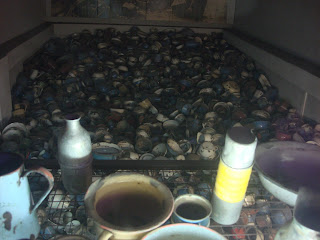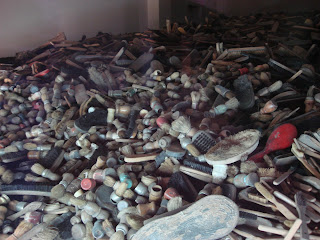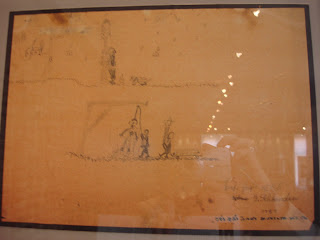I woke up at about 5:30am Saturday morning to catch the train (about 90 min) to Oswiecim, the town where the camp is located. The ride was very eerie - the train route was very quiet and desolate, and unsettling thinking that this was one of the routes that prisoners on their way to the death camp took not more than 60-70 years ago.
Here's the station:
The museum site itself is actually split into 2 concentration camps. The first, Auschwitz I, was built initially to imprison and exterminate Polish prisoners. However, the Nazis soon began to deport prisoners from all different populations to the camp, mainly Jews, Soviet POW's, and citizens of various occupied European territories: Hungarians, Romas (gypsies), Czechs, Yugoslavians, Frenchman, Austrians, and Germans. This first camp held up to 20,000 prisoners at a time. Upon arrival at the camp, the prisoners were already exhausted from the trip which was often 7-10 days cramped into a train without food, and many prisoners were already dead. Those who survived the brutal trip were forced off the train and into the camp entrance, often beaten along the way.
exhibit of childrens' shoes
One of the main causes of death in the camp was starvation - prisoners were barely fed at all and forced into excruciating work, many died while working, or of rampant disease, or of starvation. The women pictured below weighed about 130-140 pounds before arrival; and only 50-60 pounds when the camp was liberated. They were the lucky few who actually survived.
Others suffered and died of cruel experimentation.
This is the "death wall" between two of the barracks where SS guards shot or hung thousands of prisoners, often for no reason at all, and in front of the other prisoners. Prisoners could be murdered for helping a fellow sick prisoner, obtaining extra food, taking breaks while working...pretty much for anything at all.
More barracks. There is now a barrack for each of the populations who fell victim to the Nazi death camps, so you can learn more detail about the sufferings of specific ethnic groups.
Childrens' drawings...
Appalling humiliation of a female prisoner who had just given birth.
Photo of SS soldier murdering a mother holding her child.
barbed wire electric fences kept prisoners from escaping. some committed suicide by electrocution.
The gas chamber at Auschwitz I where thousands of prisoners were murdered. After death gold fillings from the teeth of prisoners were extracted and melted into blocks for future usage, in addition to any remaining hair.
After a year the SS forced the prisoners to build a second camp 3km away - Auschwitz-Birkenau II, which held up to 100,000 people at a time and became a gigantic factory of death - 75% of each new transport of prisoners was immediately sent to the gas chambers here (including 100% of all children and elderly), while the remaining 25% were seen fit to work.
Birkenau is 425 acres - you can't even see the other end when you're standing on one end. This place is absolutely huge and makes you realize how massive this operation was. The most haunting thing about this camp was just how mechanical it all was - it was really like one big assembly line of death, a place of pure evil. How anyone could commit these crimes and torture another human being like that is beyond me. It made me sick to my stomach seeing all this with my own eyes.
Entrance.
The camp stretched beyond those trees in the background, and was at least twice as wide.
Unloading dock where 3 out of 4 prisoners and all children and elderly were marched straight to the gas chambers.
Drainage ditches the prisoners dug themselves.
One of many pools / pits where dead bodies were piled; and often burned in the open air because they ran out of room in the crematoriums. Babies were thrown into the burning pits alive.
The Nazis tried to hide their crimes by blowing up all the gas chambers with dynamite just before the liberation. All that's left is the remains.
Pools where ashes were dumped.
At the very end of the train tracks you can barely see the tower of the main entrance. And the camp went almost as far back in the opposite direction.
I didn't know what to expect before visiting Auschwitz, but it really gave me a different perspective about the crimes committed during the war by seeing it with my own eyes. What was done was absolutely devastating and my heart breaks for all the men, women, and children who lost their lives and families. I still don't understand how something like this was allowed to happen, how all this was even possible. It's beyond me. But I hope that humanity can learn from this tragedy and never allow this to happen again.














































No comments:
Post a Comment